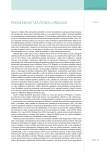-
Medical journals
- Career
Prevalence of the overactive bladder symptoms among patients of urological outpatient clinics
Authors: Jan Krhut 1; Roman Zachoval 2; Alois Martan 3; David Němec 1; Ondřej Havránek 1; Radek Sýkora 1; Kamil Švabík 3; Tomáš Hanuš 4
Authors‘ workplace: Urologické oddělení FN a LF OU, Ostrava 1; Urologické oddělení FTN, Praha 2; Gynekologicko-porodnická klinika 1. LF UK a VFN, Praha 3; Urologická klinika 1. LF UK a VFN, Praha 4
Published in: Ces Urol 2011; 15(3): 181-188
Category: Original article
Overview
Aim:
The issue of the overactive bladder (OAB) is one of the most actual topics of the current urology. The OAB is characterized by the presence of severe urgency with or without incontinence, mostly accompanied by frequency and nocturia. Urgency is defined as a sudden compelling desire to pass urine, which is difficult to defer. The OAB in adult population is estimated at about 10–12%; however, most of the patients are not diagnosed even treated. The aim of this study is to evaluate the OAB prevalence in the specific population of patients of the urological outpatient clinic.Material and methods:
Five hundred consecutive patients over 18 years old of five general urological outpatient clinics were included in this study. The OAB prevalence was determined by combination of self-assessment questionnaire “Bladder Control Self Assessment Questionnaire (BCSAQ)” and direct questioning by an urologist. BCSAQ response rate was 68.4 %; direct questioning by a doctor was carried out by in sum of 94% of patients. Results obtained from this study were compiled using methods of descriptive statistics.Results:
Overactive bladder prevalence reached 23.6% according to results of the BCSAQ evaluation. No significant difference in overactive bladder prevalence between men and women was discovered (23.1% vs. 24.5%). It was found by the analyses of direct questioning by a doctor that overall 301 (64%) of patients declared occasional urgency occurrence; 43 (9.1%) patients stated urge incontinence. Only 198 (42%) of questioned patients were able to speak about the urgency and incontinence openly and without feeling ashamed.Conclusion:
OAB prevalence among the patients of the urological outpatient clinics is considerably higher than in the common population. In regard of the negative influence of the OAB on the quality of life, it could be recommended to actively search for the patients who can potentially profit from further examination and eventual treatment of the OAB.Key words:
urgency, overactive bladder, urology, prevalence, incontinence.
Sources
1. Abrams P, Cardozo L, Fall M, et al. Standardisation Sub-Committee of the International Continence Society: The standardisation of terminology in lower urinary tract function: report from the standardisation sub-committee of the International Continence Society. Neurourol Urodyn 2002; 21 : 167–178.
2. Temml C, Heidler S, Ponholzer A, et al. Prevalence of the overactive bladder syndrom by applying the Interantional Continence Society definition. Eur Urol 2005; 48(4): 622–627.
3. Irwin D, Mungapen L, Milsom I, et al. The economic impact of overactive bladder syndrome in six western contries. BJU Int 2009; 103 : 202–209.
4. Milsom I, Abrams P, Cardozo L, et al. How widespread are the symptoms of an overactive bladder and how are they managed? A population-based prevalence study. BJU Int 2001; 87 : 760–766.
5. Cheung WW, Blank W, Borawski D, et al. Prevalence of Overactive Bladder, its Under-Diagnosis, and Risk Factors in a Male Urologic Veterans Population. Int J Med Sci 2010; 7(6): 391–394.
6. Kinchen KS, Burgio K, Diokno AC, et al. Factors associated with women‘s decisions to seek treatment for urinary incontinence. J Womens Health (Larchmt) 2003; 12(7): 687–698.
7. Luber KM, Boero S, Choe JY. The demographics of pelvic floor disorders: current observations and future projections. Am J Obstet Gynecol 2001; 184(7): 1496–1501.
8. Tikkinen KAO, Tammela TLJ, Rissanen AM, et al. Is the prevalence of overactive bladder overestimated? A population – based study in Finland. PloS ONE 2007; 2(2):e195.doi:10.1371/ journal.pone.000195
9. Parazzini F, Lavezzari M, Artibani W. prevalence of overactive bladder and urinary incontinence. J Fam Pract 2002; 51(12): 1072–1075.
10. McGrother CW, Donaldson MM, Shaw C, et al. Storage symptoms of the bladder: prevalence, incidence and need for services in the UK. BJU Int 2004; 93(6): 763–769.
11. Finkelstein K, Glosner S, Sanchez RJ, et al. Prevalence of probable overactive bladder in a private obstetrics and gynecology group practice. Curr Med Res Opin 2008; 24(4): 1083–1090.
12. Coyne KS, Zyczynski T, Margolis MK, et al. Validation of an overactive bladder awarness tool for use in primary care settings. Adv Ther 2005; 22 : 381–394.
13. Ricci JA, Bagish JS, Hunt TL, et al. Coping strategies and health care-seeking behavior in a US national sample of adults with symptoms suggestive of overactive bladder. Clin Ther 2001; 23 : 1245–1259.
14. Stewart WF, Van Rooyen JB, Cundiff GW, et al. Prevalence and burden of overactive bladder in the United States. World J Urol 2003; 20 : 327–336.
Labels
Paediatric urologist Nephrology Urology
Article was published inCzech Urology

2011 Issue 3-
All articles in this issue
- INTEGRATION OF SURGERY AND MOLECULAR TARGETED THERAPY IN ADVANCED RENAL CELL CARCINOMA
- EARLY SURGICAL MANAGEMENT OF URETERAL TRAUMA
- Contribution of laparoscopy in diagnostics and treatment of non-palpable testes
- Genitourinary tract infections in patient history do not correlate with prostate cancer biological behaviour and prognosis
- Prevalence of the overactive bladder symptoms among patients of urological outpatient clinics
- Late secondary bleeding after percutaneus nephrolithotomy
- EBU CERTIFICATION OF POST-GRADUATE EDUCATION AT THE DEPARTMENT OF UROLOGY, UNIVERSITY HOSPITAL, PLZEŇ, CZ
- Czech Urology
- Journal archive
- Current issue
- Online only
- About the journal
Most read in this issue- EARLY SURGICAL MANAGEMENT OF URETERAL TRAUMA
- Contribution of laparoscopy in diagnostics and treatment of non-palpable testes
- Late secondary bleeding after percutaneus nephrolithotomy
- Prevalence of the overactive bladder symptoms among patients of urological outpatient clinics
Login#ADS_BOTTOM_SCRIPTS#Forgotten passwordEnter the email address that you registered with. We will send you instructions on how to set a new password.
- Career

